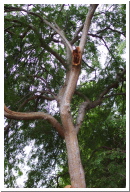Why trees fall?
 We recently had a few days of high winds here in Los Angeles, and every time this occurs you will find trees down all over the city. I often wonder what causes some trees to fail and others to remain upright in the face of such high winds and there seems to be a few common issues that might be avoided if homeowners paid a bit more attention to the trees on their property.
We recently had a few days of high winds here in Los Angeles, and every time this occurs you will find trees down all over the city. I often wonder what causes some trees to fail and others to remain upright in the face of such high winds and there seems to be a few common issues that might be avoided if homeowners paid a bit more attention to the trees on their property.Broken limbs
If an entire tree does not fall in a windstorm, it may shed limbs both large and small. Typically, I find the that these limbs were already severely compromised by other issues and the wind simply stressed them to the point of failure. Too often, trees and not pruned according to any deep knowledge of arborology, but limbs are simply hacked away to achieve some desired result -- such as getting limbs off the roof, etc. Even worse, trees are often simply ignored and allowed to develop problems that will later cause their failure. I often see fallen limbs that have been long dead before they fell. Leaving dead limbs in a any tree is a dangerous, yet people often never notice the problem before it is too late or simply ignore it.
The worst case of a broken limb is one in which the trunk splits down its entire length. I have seen this occur when the trunk has a very steep crotch that allows water and debris to collect. Over time this water can invade the trunk and eventually cause rot. Then even a slight wind can stress the point to fracture.
Inspect your trees regularly and have them pruned regularly by a knowledgeable crew. This preventive maintenance can go a long way towards protecting you and your property when high winds, rain and ice arrive.
Compromised roots
Another common cause for failure I see here in Los Angeles is compromised roots. In our near-desert environment, we get most of our rain over a few Winter months. The heaviest storms can leave the ground saturated and poorly rooted trees can topple over from their own weight. Again, poor pruning practices can often be the cause, but other damage to the tree, such as root pruning due to construction can also complicate matters. Often, you could have foretold that the tree was going to fail, due to an obvious top-heaviness or pronounced lean. In some cases, pruning might be able to alleviate the strain to some degree, but in the worst cases, the tree will have to be removed. No one likes to remove a mature tree, but taking the tree out on your terms is much preferable to having it come down in the worst place, as the worst time.
Your trees are living beings and should be treated as such. Watch for signs of disease, old age and infirmity. Practice good pruning and keep your trees around, safely, for years to come.
Link: Fallen tree limb photos
Link: What is certified arborist? from Wikipedia.org




1 Comments:
Thank you for sharing this Douglas, it was helpful in understanding the storm here in LA that just passed. I just walked by a mature fallen tree in my neighborhood, and it was still rooted in the ground while the body was laying on the side walk. I felt sad for it. Do trees feel pain?
Elaina
Post a Comment
<< Home